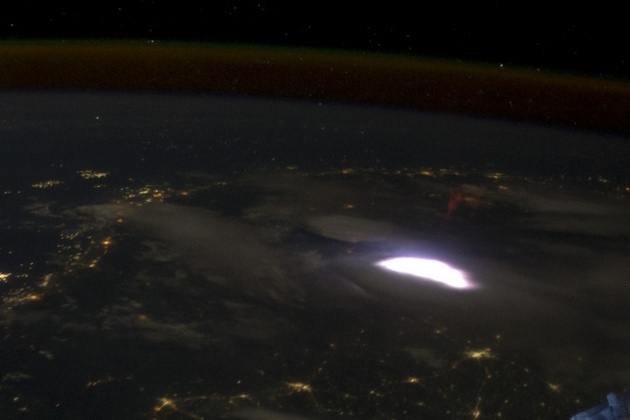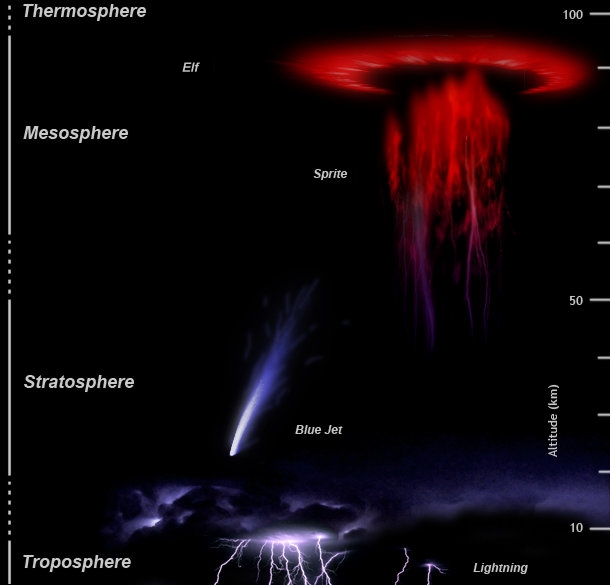
A Red Sprite taken from the ISS, via Wikimedia
For astronauts aboard the International Space Station, the view of the Earth isn’t just space age eye candy. It’s a unique perspective from which they can shed light on nagging questions about our home planet. It’s a perspective scientists exploit by sending remote experiments to the station in their stead, experiments like Firestation, which is designed to study the obscure side of a phenomenon we’re all pretty familiar with: lightning.
The lightning we all know and love (or hate, perhaps) is those jagged columns of light that heat the air to 50,000°F as they plunge from electrically charged clouds towards the Earth. But lightning doesn’t exclusively move down towards Earth from clouds. Lightning in the upper atmosphere can also move up from storm clouds into space.
It’s only recently that scientists discovered the strange lightning-related phenomena happening in the tops of clouds. There are red sprites, blue jets, and elves, cold forms of lightning that shoot upwards from storm clouds. There are strange jets of antimatter that also fly upwards, triggering the detectors on NASA's orbiting high-energy observatories. There are even gamma ray bursts that happen as often as 500 times a day during which Earth briefly mimics a supernova. These are known, appropriately, as Terrestrial Gamma-ray Flashes or TGFs.
Scientists know these phenomena exist, but no one is entirely sure how they relate to the lightning on the lower half of the cloud that we see during a thunderstorm. Hopefully this will change soon, thanks to Firestation, a package of sensors designed to explore the links between TGFs, ordinary lightning, and sprites.
Firestation’s principal investigator Doug Rowland from NASA's Goddard Space Flight Center calls the ISS the perfect platform from which to explore these cloud-top lightning phenomena. During the experiment’s one year lifetime, the ISS will carry the bevy of sensors over thousands of active thunderstorms. He hopes that from this vantage point, Firestation will see up to 50 lightning strikes per day and at least one TGF every few hours.

A diagram showing the relative heights of various forms of lightning. via
With each storm, Firestation will gather plenty of data. Unlike previous upper atmospheric lightning experiments, it has the unique ability to observe thunderstorms in multiple wavelengths at the same time. In one go the detector can record radio static from lightning; measure the optical glow of lightning, red sprites, and blu elves; and detect gamma-rays and electrons associated with TGFs and any other antimatter events.
The TGFs are of particular interest. Right now, scientists don’t know for sure which type of lightning produces the surprisingly high-energy gamma-ray flashes they’ve seen. Gamma-rays are thought to come from the hottest and violent places in the universe, so their appearance at the top of our planet’s cold atmosphere is quite a surprise. Something up there is accelerating low-energy particles of air to nearly the speed of light to produce this gamma-radiation and the occasional burst of antimatter. Scientists want to know what this “something” is, and Firestation is going to unlock the mystery.
After gathering data from so many types of phenomena across so many wavelengths, researchers should be able to sort out the cause-and-effect connections between these lighting events.
Firestation was delivered to the ISS on Aug. 3, 2013, by the Japanese robotic cargo vessel Kounotori-4. It’s already been installed on the station’s exterior and the sensors have been checked out. All that’s left is to start the experiment, which is slated to happen this month. Once Firestation is up and running, scientists expect it will be only a matter of weeks before the biggest mysteries of upper atmospheric lightning are answered, adding these phenomena to the list of questions answered thanks to the space age.
By Amy Teitel 18 hours ago

Aucun commentaire:
Enregistrer un commentaire